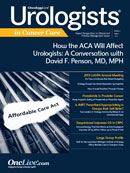Publication
Article
Oncology Live Urologists in Cancer Care®
Five Ways the ACA Will Affect Urology Practices: Insights from a health policy expert
Author(s):
Organization into large group practices will be a key way for urologists to successfully navigate a healthcare system that continues to be fraught with an enormous amount of change, a keynote speaker said during LUGPA's annual meeting in Chicago in November.
Robert Laszewski
Organization into large group practices will be a key way for urologists to successfully navigate a healthcare system that continues to be fraught with an enormous amount of change, a keynote speaker said during LUGPA’s annual meeting in Chicago in November.
In the speech, Robert Laszewski, president of Health Policy and Strategy Associates, discussed the Affordable Care Act (ACA) and its anticipated impact on community urologists.
Through his Washington,DC consulting firm, Laszewski helps health insurers, hospitals, and physician groups to weather the ongoing changes in healthcare policy and the marketplace. During the LUGPA meeting, he warned an audience of several hundred urologists and practice coordinators about the challenges inherent in adapting to the ACA, adding that those hurdles will be further complicated by uncertainty in the healthcare arena due to issues including the national debt and the growing cost of sustaining the Medicaid and Medicare programs.
To respond most effectively to most of those issues, being organized into large group practices will be crucial, Laszewski suggested.
“There’s no way the physician community can respond to what is going on if you remain small-scale,” he said. “You have to be organized into large group practices, like you are, to be able to keep up with these changes. You’re at the cutting edge.”
Laszewski’s talk included five key messages:
1. Due to initial glitches in the health insurance exchange website, the cost of the health plans to Americans, and the government’s lack of power to collect fines for non-participation, the blizzard of relatively healthy people expected to buy insurance coverage under the ACA may turn out instead to be a dusting, driving up insurance rates and making the new system unsustainable.
“These plans are half or one-third of their regular price, but in the shoes of middle-class people, this will still be a hard financial decision to make,” Laszewski said. “Those who do enroll will come to your offices with $45, $50, or $65 specialist co-pays and a $2,000 deductible for other services you provide in your offices, like tests.”
2. So far, the US Department of Health and Human Services has had a 10%-50% error rate in the data it has sent to insurance companies about newly enrolled patients.
“If the administration doesn’t get this fixed soon, it will mean that people don’t get their bank accounts debited correctly, and then they come into your offices and they’re not in your system, and then they don’t get their claims paid,” Laszewski said. “If hundreds of thousands of people suddenly enroll, we could have the customer service meltdown of all time.”
3. Many Medicare and Medicaid health plans are being shifted to the private sector for management by insurance companies in the form of traditional health plans or HMOs.
“Medicare or Medicaid patients will now often come to you through an HMO or a health insurance company that wants to do a deal,” Laszewski said. “You’ve got to be organized and have scale to be able to do that deal.”
4. Even employers that compete for talent are likely to decrease the value of the health benefits they offer, seeking only to provide something better than the narrow networks and $2,000-deductible plans offered under the ACA. Employers that don’t rely on skilled workers are likely to consider phasing health insurance out, and employers that continue to offer plans will shift more payment responsibility to their workers.
“There is going to be a 40% ‘Cadillac’ excise tax on the cost of any health insurance offered by employers that is above a specific threshold cited in the ACA,” Laszewski said. “According to a 2013 Towers Watson survey of 428 large employers, 60% of those surveyed think their plans will be hit by that tax in 2018, so they will ratchet back their plans by increasing deductibles and taking benefits away. That means that people insured through commercial plans will come to your offices with much higher deductibles and copays than ever before. They’ll pay in cash out of their pockets, and it will be an issue in terms of reimbursement, because the insurance companies will not guarantee some of these costs.”
5. Forming or joining accountable care organizations may be a way for urologists to regain some control over their ability to thrive in the changing healthcare marketplace.
“More and more patients are covered by these kinds of organizations, and they are more and more often being led by physician groups,” Laszewski said. “There are lots of reasons why providers are interested in forming ACOs, from the most altruistic to the most defensive. It’s an opportunity not just to better manage costs and quality, but to more efficiently negotiate. Physicians are beginning to understand that, if they’re going to do this, it should be for reasons that meet their needs, and not because they’ve become pawns in hospital organizations. But no one should go into an ACO thinking they’ve figured out how to make money— they need to go in realizing they’re on training wheels.”










